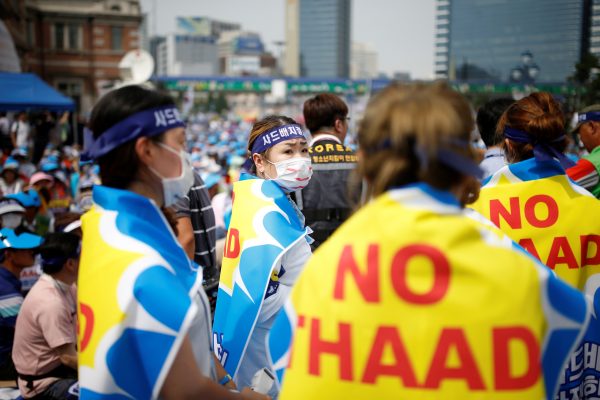In the eyes of Chinese leaders, THAAD is another US-led military containment effort in the Asia Pacific. But North Korea’s nuclear tests further complicate the matter.
What happened after the latest nuclear test? The United States blamed China for North Korea’s actions, South Korea started plans to expedite THAAD’s deployment and the UN Security Council looked at more serious sanctions against North Korea. But all of these responses were useless. Policy solutions need to be more inventive.
North Korea’s nuclear tests have revealed two facts. First, although Beijing cannot control its ‘rogue ally’ in Pyongyang, blaming China for North Korea’s actions doesn’t help either. Second, the THAAD system will not protect South Korea if it antagonises China and Russia. On the flip side, China and Russia will not work together with South Korea and the United States if they feel threatened by THAAD.
All of this comes back to the traditional realist notion of the ‘security dilemma’, a product of the anarchic nature of the international system. If State A intends to increase its security — usually done through acquiring weapons — State B will become suspicious and, in turn, strengthen its own military capabilities. An arms race will ensue between the two states and security tensions will increase.
While South Korea and the United States claim that THAAD is a purely defensive weapons system, Chinese leaders see it as undermining their own military influence in the region. As a result, China and Russia have both decided to increase their military cooperation. Arms races and a new Cold War in Northeast Asia may be on the horizon.
There are two capitals that have cause for celebration. Washington — especially the Pentagon — believes that Seoul’s support for THAAD is a positive for the US ‘rebalance’ towards Asia. But despite some short-term benefits from this ‘wedging’ strategy, the United States will eventually face its own security dilemma. THAAD may push China and Russia to tighten their military cooperation, eroding US primacy in the region.
Pyongyang will also benefit from THAAD’s deployment. One week after the United States and South Korea announced THAAD, North Korea launched three ballistic missiles into the sea as a ‘physical response’. If there is one country that wants a new Cold War on the Peninsula it is North Korea, with the Kim dynasty’s survival being closely linked to domestic and international fear levels.
The states involved should work on two solutions to solve this dilemma. First, they must clearly differentiate between defensive and offensive weapons. If South Korea can assure China that the THAAD system will not impact Chinese security then China might just let it go. Some Chinese scholars suggest that South Korea should change the radar system of THAAD from the powerful TPY-2 to the less-capable Green Pine Radar, which would not penetrate China’s security. The problem with this type of approach is that the distinction between defensive and offensive weapons is ambiguous. If the THAAD system is still part of a US missile defence system in the region then no matter which radar South Korea uses the military balance between the United States and China will be altered.
Another potential solution is to reduce security concerns among the major powers by building stronger institutions. During the Cold War, the arms control treaties between the United States and the Soviet Union, to a certain extent, played a pacifying role.
To ease some of this regional tension China should propose a four-party security agreement in which China, the United States and Russia provide security guarantees to South Korea in response to a North Korean threat. With this security guarantee, South Korea could then withdraw its THAAD system because it would fall under the security umbrella of the three most powerful states on the planet. This institutional approach addresses the THAAD predicament on the Peninsula and also encourages the United States and South Korea to work with China and Russia — a rare occurrence in international relations.
Kai He is Associate Professor of International Relations at Griffith Asia Institute and Centre for Governance and Public Policy, Griffith University. Huiyun Feng is Senior Lecturer of International Relations at the School of Government and International Relations, Griffith University.


Thanks for this article and its suggestions.
I read that the Green Pine short range system would have been much more useful when targeted at the North Koreans than the THAAD long range system is, so the choice of the THAAD, which can be easily swivelled to target deep into China, seems to suggest that its real purpose is to contain China.
Thanks for an interesting analysis. It is particularly relevant that the Director of National Security in the USA, James Clapper, just noted publicly that it is not likely that N Korea will ever give up its nuclear capabilities. Finally, someone high up in the US government is being realistic!
I am afraid the suggestions at the end of this piece are lacking in that element. While it is fascinating to consider, how likely is it that China and Russia would even seriously entertain any offer of security for the South?
In the larger geopolitical scheme of things each one is heavily invested in keeping the USA struggling to sustain its dominance in world affairs. From the E/S China Seas to Ukraine and Syria both China and Russia are more interested in pursuing their own ‘rise’ in power at the expense of the USA. Why would they want to lessen tensions on the Korean Peninsula so the USA could devote more energy to these other ‘hot spots’ in the world?
While I think the analysis is sensible, I’m very surprised that an article proclaiming to contribute to ‘solving Northeast Asian security’ does not contain a single reference to Japan. Is Japan really that irrelevant?